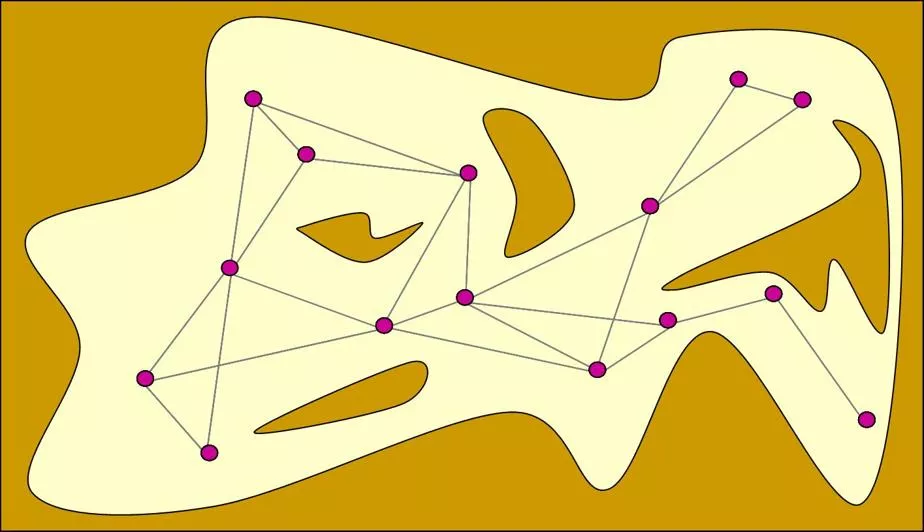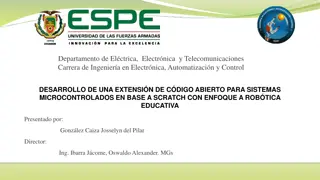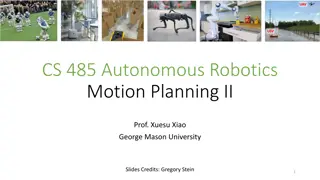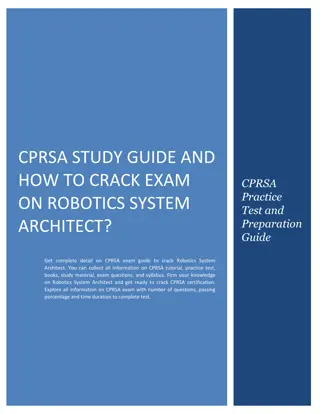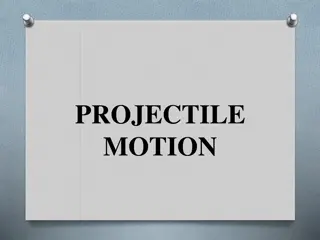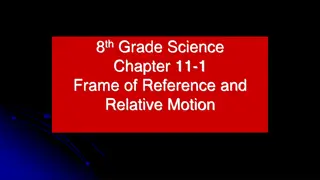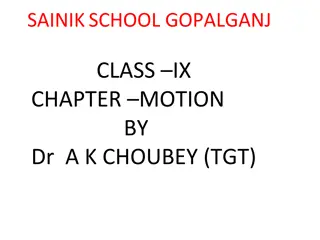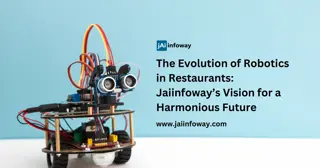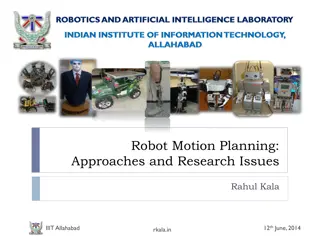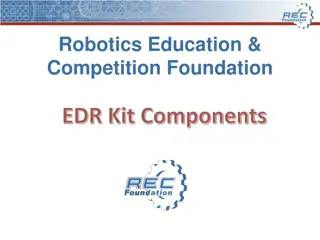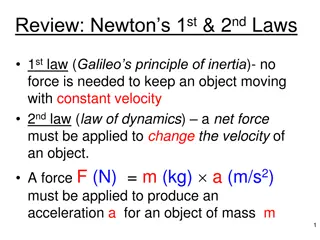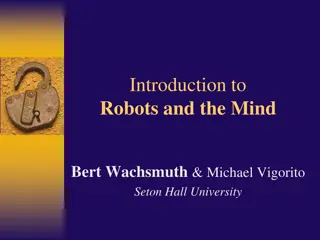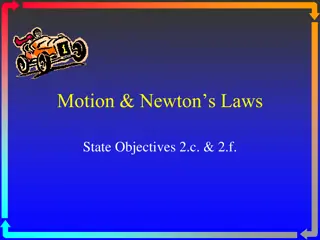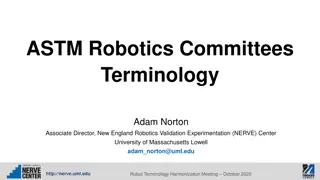Motion Planning Strategies for Robotics
Motion planning in robotics involves techniques such as tree-growing sample-based planning, probabilistic roadmaps, and Rapidly-exploring Random Trees (RRTs). These methods focus on efficiently navigating complex environments while considering constraints like limited visibility and space exploration requirements.
Download Presentation

Please find below an Image/Link to download the presentation.
The content on the website is provided AS IS for your information and personal use only. It may not be sold, licensed, or shared on other websites without obtaining consent from the author. Download presentation by click this link. If you encounter any issues during the download, it is possible that the publisher has removed the file from their server.
E N D
Presentation Transcript
Tree-Growing Sample-Based Motion Planning
Probabilistic Roadmaps What if only a small portion of the space needs to be explored? What if omnidirectional motion in C-space is not permitted?
Tree-growing planners Idea: grow a tree of feasible paths from the start until it reaches a neighborhood of the goal Sampling biastoward boundary of currently explored region, helps especially if the start is in a region with poor visibility Many variants: Rapidly-exploring Random Trees (RRTs) are popular, easy to implement (LaValle and Kuffner 2001) Expansive space trees (ESTs) use a different sampling strategy (Hsu et al 2001) SBL (Single-query, Bidirectional, Lazy planner) often efficient in practice (Sanchez-Ante and Latombe, 2005)
RRT Build a tree T of configurations, starting at xstart Extend: Sample a configuration xrand from C at random Find the node xnear in T that is closest to xrand Extend a short path from xnear toward xrand T
RRT Build a tree T of configurations, starting at xstart Extend: Sample a configuration xrand from C at random Find the node xnear in T that is closest to xrand Extend a short path from xnear toward xrand xnear xrand
RRT Build a tree T of configurations, starting at xstart Extend: Sample a configuration xrand from C at random Find the node xnear in T that is closest to xrand Extend a short path from xnear toward xrand xnear xrand
RRT Build a tree T of configurations, starting at xstart Extend: Sample a configuration xrand from C at random Find the node xnear in T that is closest to xrand Extend a short path from xnear toward xrand xnear xrand
RRT Build a tree T of configurations, starting at xstart Extend: Sample a configuration xrand from C at random Find the node xnear in T that is closest to xrand Extend a short path from xnear toward xrand
RRT Build a tree T of configurations, starting at xstart Extend: Sample a configuration xrand from C at random Find the node xnear in T that is closest to xrand Extend a short path from xnear toward xrand xrand xnear
RRT Build a tree T of configurations, starting at xstart Extend: Sample a configuration xrand from C at random Find the node xnear in T that is closest to xrand Extend a short path from xnear toward xrand
RRT Build a tree T of configurations, starting at xstart Extend: Sample a configuration xrand from C at random Find the node xnear in T that is closest to xrand Extend a short path from xnear toward xrand Governed by a step size parameter
Implementation Details Bottleneck: finding nearest neighbor each step O(n) with na ve implementation => O(n2) overall KD tree data structure O(n1-1/d) Approximate nearest neighbors often very effective Terminate when extension reaches a goal set Usually visibility set of goal configuration Bidirectional strategy Grow a tree from goal as well as start, connect when closest nodes in either tree can see each other
What is the sampling strategy? Probability that a node gets selected for expansion is proportional to the volume of its Voronoi cell
Planning with Differential Constraints (Kinodynamic Planning)
Setting Differential constraints Dynamics, nonholonomic systems dq/dt = kfk(q)uk Vector fields Controls We ll consider fewer control dimensions than state dimensions
Example: 1D Point Mass Mass M x v 2D configuration space (state space) Controlled force f Equations of motion: dx/dt = v dv/dt = f / M
Example: 1D Point Mass x v dx/dt = dv dv/dt = f / M v f=0 Solution: v(t) = v(0)+t f /M x(t) = x(0)+t v(0) + t2 f / M x
Example: 1D Point Mass x v dx/dt = dv dv/dt = f / M v f>0 Solution: v(t) = v(0)+t f /M x(t) = x(0)+t v(0) + t2 f / M x
Example: 1D Point Mass x v dx/dt = dv dv/dt = f / M v f<0 Solution: v(t) = v(0)+t f /M x(t) = x(0)+t v(0) + t2 f / M x
Example: 1D Point Mass x v dx/dt = dv dv/dt = f / M v |f|<=fmax Solution: v(t) = v(0)+t f /M x(t) = x(0)+t v(0) + t2 f / M x
Example: Car-Like Robot dx/dt = v cos dy/dt = v sin dx sin dy cos = 0 L d dt = (v/L) tan y | < x Configuration space is 3-dimensional: q = (x, y, ) But control space is 2-dimensional: (v, ) with |v| = sqrt[(dx/dt)2+(dy/dt)2]
Example: Car-Like Robot dx/dt = v cos dy/dt = v sin dx sin dy cos = 0 L d dt = (v/L) tan y | < x q = (x,y,q) q = dq/dt = (dx/dt,dy/dt,dq/dt) dx sinq dy cosq = 0is a particular form of f(q,q )=0 A robot is nonholonomic if its motion is constrained by a non- integrable equation of the form f(q,q ) = 0
Example: Car-Like Robot dx/dt = v cos dy/dt = v sin dx sin dy cos = 0 L d dt = (v/L) tan y | < x Lower-bounded turning radius
How Can This Work? Tangent Space/Velocity Space L (x,y, ) (dx,dy,d ) y x dx/dt = v cos dy/dt = v sin y (dx,dy) d dt = (v/L) tan x | <
How Can This Work? Tangent Space/Velocity Space L (x,y, ) (dx,dy,d ) y x dx/dt = v cos dy/dt = v sin y (dx,dy) d dt = (v/L) tan x | <
Nonholonomic Path Planning Approaches Two-phase planning (path deformation): Compute collision-free path ignoring nonholonomic constraints Transform this path into a nonholonomic one Efficient, but possible only if robot is controllable Need for a good set of maneuvers Direct planning (control-based sampling): Use control-based sampling to generate a tree of milestones until one is close enough to the goal (deterministic or randomized) Robot need not be controllable Applicable to high-dimensional c-spaces
Control-Based Sampling PRM sampling technique: Pick each milestone in some region Control-based sampling: 1. Pick control vector (at random or not) 2. Integrate equation of motion over short duration (picked at random or not) 3. If the motion is collision-free, then the endpoint is the new milestone Tree-structured roadmaps Need for endgame regions
Example dx/dt = v cos dy/dt = v sin d dt = (v/L) tan | < 1. Select a milestone m 2. Pick v, , and t 3. Integrate motion from m new milestone m
Example Indexing array: A 3-D grid is placed over the configuration space. Each milestone falls into one cell of the grid. A maximum number of milestones is allowed in each cell (e.g., 2 or 3). Asymptotic completeness: If a path exists, the planner is guaranteed to find one if the resolution of the grid is fine enough.
Computed Paths Tractor-trailer Car That Can Only Turn Left max=45o, min=22.5o max=45o
Control-Sampling RRT Configuration generator f(x,u) Build a tree T of configurations Extend: Sample a configuration xrand from X at random Find the node xnear in T that is closest to xrand Pick a control u that brings f(xnear,u) close to xrand Add f(xnear,u) as a child of xnearin T
Weaknesses of RRTs strategy Depends on the domain from which xrand is sampled Depends on the notion of closest A tree that is grown badly by accident can greatly slow convergence
Other strategies Dynamic-domain RRTs (Yershova et al 2008) Perturb samples in a neighborhood (EST, SBL) Lazy planning: delay expensive collision checks until end





